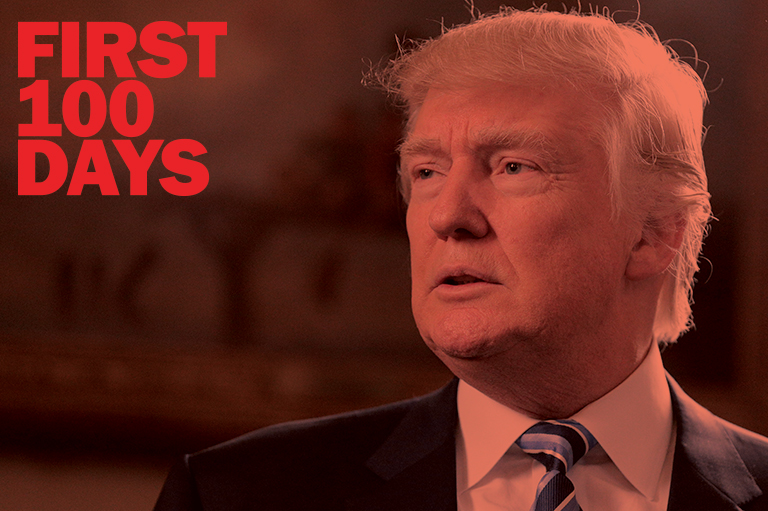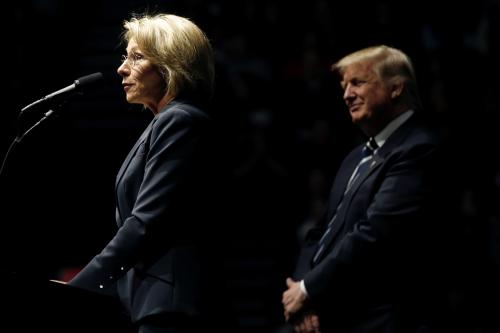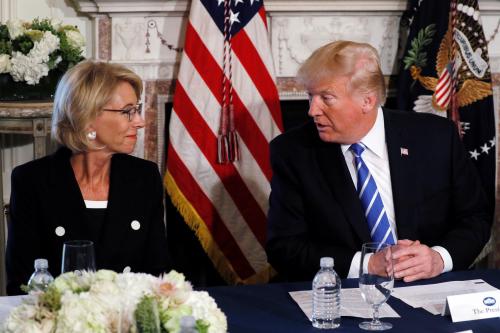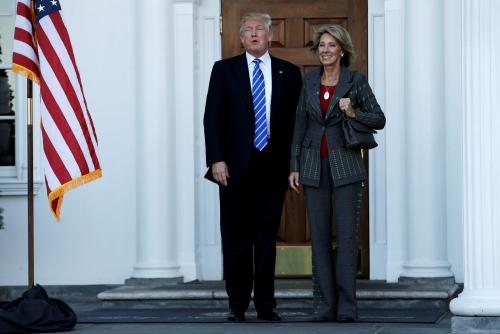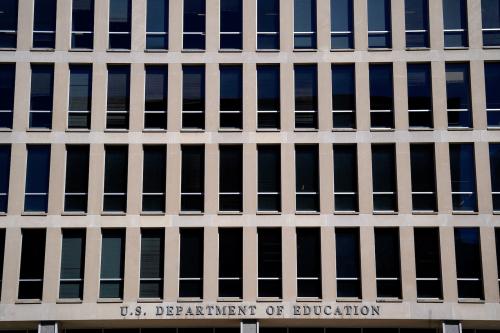To assess President Donald Trump’s first 100 days of education governance is to assess a president who fundamentally believes that a president should not do much education governing. Trump has repeatedly expressed a desire to increase local control of schools, and just last week he signed an executive order that calls for a review of federal overreach in education.
Between Trump’s reluctance to engage in education policy and the recent passage of the Every Student Succeeds Act (ESSA), which provided states with greater control over education policymaking, one might have expected a relatively quiet first 100 days for Trump and the Department of Education. However, beginning with Trump’s controversial nomination of Education Secretary Betsy DeVos, the first 100 days have been anything but quiet.
Here, we review the key focus areas of the first 100 days for Trump and DeVos. We consider not only what has already happened—which, with respect to policymaking, has been modest—but also the signals of what might come.
Promoting School choice
Perhaps the most consistent, controversial drumbeat of education news from the Trump administration’s early days has been its promotion of school choice reforms. DeVos has an unconventional background for an education secretary, coming to the Department of Education from a school choice advocacy group, the American Federation for Children, that was supported by the DeVos family’s private wealth. Her comments and public appearances to date reflect a strong commitment to expanding parents’ school choice options, whether those options are charter, district, or private schools. The degree of antagonism toward public schools in those comments has varied, from calling public schools (and their supporters) “the backbone of our education system” to “the entrenched status quo.” However, DeVos’s support for school choice reforms has not wavered, nor has the chilly reception she received from Democrats and, especially, interest groups such as teachers unions.
A legislative effort on school choice appeared in Trump’s “Contract with the American Voter” for his first 100 days in office. He pledged to work with Congress to introduce and pass the “School Choice and Education Opportunity Act,” which would redirect funds to school choice programs (among other priorities). That has not happened, although Trump’s “skinny budget” proposed increased funding for an assortment of school choice programs. A widely anticipated federal tax-credit scholarship program—which could have helped Trump fulfill a campaign pledge for $20 billion in federal funding for school choice programs—appears to be on hold, leaving uncertainty about what is to come. However, with state governments better positioned to enact school choice reforms than the federal government, the administration’s school choice efforts might focus on public advocacy and encouragement for states to prioritize choice programs in their ESSA plans.
ESSA implementation
Perhaps the most significant federal policy action in Trump’s first 100 days was, in fact, a rollback of federal authority. Trump signed a congressional resolution to repeal the Obama administration’s State Plan and Accountability rule. This rule had specified requirements for state accountability plans under ESSA. With the repeal of the embattled rule, the Trump administration indicated that they are likely to take a hands-off approach to federal oversight of state policymaking under ESSA. Indeed, during her confirmation, DeVos vowed to grant states “maximum flexibility” to implement the new law. At least initially, she seems to be sticking to this approach: EdWeek reports that the Department of Education’s newly released state accountability plan application template “is shorter and includes fewer requirements than an earlier application released by the Obama administration in November.”
The Department of Education will review and approve state plans for implementing the law in the coming months. Twelve states and D.C. have submitted plans thus far, and the next deadline for states to submit application is in September. As applications continue to trickle in, the department’s review of decisions over the summer and fall will shed more light on just how much deference it will show states, setting the stage for the federal-state balance of power in the early years of the ESSA era.
A shrinking education Budget?
The “skinny budget” that Trump initially proposed also reflects his perception of education as primarily a state and local responsibility rather than a federal responsibility. For example, Trump’s original budget proposed cutting the Education Department’s funding by 13.5 percent ($9.2 billion). With the budget process unfolding in fits and starts—and the current congressional budget agreement more generous toward education programs (and Democratic priorities) than Trump’s proposal—the fate of specific programs that Trump initially proposed cutting remains unclear. However, the current spending bill to fund the government through September would decrease research funding for the department’s Institute of Education Sciences by $12.7 million. The Department of Education has also sought guidance for conducting a “reduction in force” for its own employees. Together, these signs point toward a decreased federal footprint in education.
focusing on Civil rights
Historically, one of the federal government’s primary responsibilities in education has been the protection of students’ civil rights. The Obama administration actively engaged on a number of civil rights issues. This included bathroom access for transgender students, disparities in exclusionary discipline across student subgroups, and Title IX enforcement to address sexual assault on college campuses. Conservatives pointed to the growing influence of the Department of Education’s Office of Civil Rights (OCR) as a prime example of executive overreach, and civil rights advocates have nervously watched for an expected slowdown in OCR activity. An early clash between DeVos and Attorney General Jeff Sessions revealed DeVos’s reluctance to rescind protections for transgender students—a battle that DeVos ultimately lost. More recently, DeVos’s choice of Candice Jackson as acting head of OCR has raised eyebrows in light of Jackson’s thin résumé in protecting students’ rights and past writing on reverse discrimination against white students.
Higher education under Trump
While the Trump administration has intimated that it may make several dramatic changes in the higher education space, little of that has come to fruition at this point. It has not yet rolled back the Obama administration’s guidance on Title IX with regard to how colleges prosecute campus sexual assault, as many expected it might. Nor has it changed course from the Obama administration’s approach of holding for-profit colleges accountable, although many believe it is almost certain that they will do so, in part because of DeVos’s and Trump’s past investments in the for-profit education sector. However, the administration has revoked Obama-era guidance to protect individuals who default on their student loans. In addition, Republicans used the Congressional Review Act to repeal ESSA guidelines for teacher preparation programs issued in the final weeks of the Obama administration.
With respect to higher education legislation, Sen. Lamar Alexander (R-Tenn.), the chairman of the Senate’s Health, Labor, Education, and Pensions committee, has signaled that reauthorizing the Higher Education Act (HEA) is at the top of his agenda. The Trump administration has thus far not taken concrete action on this issue, such as proposing a blueprint for the law’s reauthorization. It could be the case that Alexander—himself a former secretary of education, university president, and a major architect of ESSA—shepherds HEA reauthorization through Congress without needing guidance or negotiation help from the White House. If he is successful, it seems virtually guaranteed that Trump would sign a higher education bill passed by the Republican-controlled Congress.
Rough waters ahead?
The Trump administration’s first 100 days have featured more bark (in rhetoric) than bite (in tangible policy). To some extent, this might be by design, as it actively seeks to scale back the federal government’s role in education. It may also be the product of a slow start in filling key roles in the Department of Education.
Perhaps the most notable takeaway from the first 100 days of Trump and DeVos’s leadership, however, has not been any particular policy or staffing decision. Rather, it has been the extraordinary controversy surrounding the Department of Education. DeVos’s confirmation hearings attracted unprecedented attention for an education secretary, and that negative attention has persisted, following her at public events. This seems likely to continue, as many continue to perceive this administration as antagonistic to public education.
Politics and policymaking, of course, are closely intertwined. Federal policymakers may find that heightened scrutiny of the Department of Education shapes which of the priorities described above they can—and cannot—pursue. Perhaps more than ever, federal policymaking in education will happen under the watchful eye of the American public.
The Brookings Institution is committed to quality, independence, and impact.
We are supported by a diverse array of funders. In line with our values and policies, each Brookings publication represents the sole views of its author(s).





